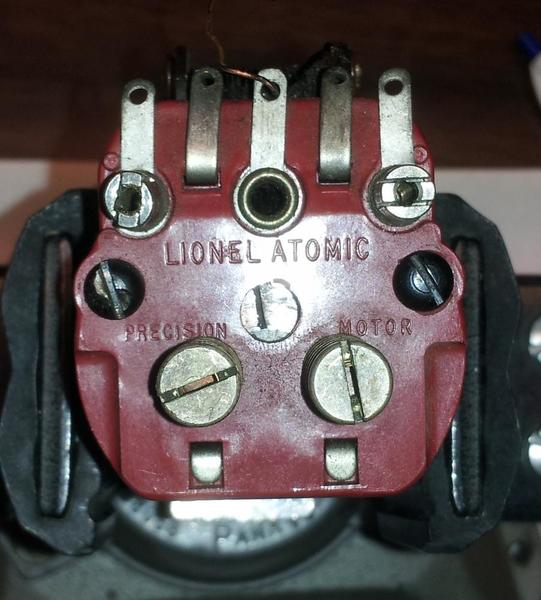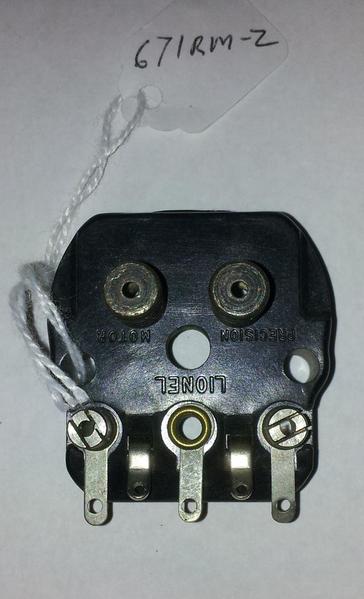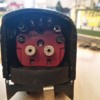My apologies for arriving at this thread late. Someone was gracious enough to send me a link back in June and we were right in the middle of finishing our new building and shop and getting ready to move in – then the season started. I’ve read through this thread and there’s some good information as well as some misinformation and conjecture, so let me start at the top.
I’ve been working with Lionel manufactured items, including the high stack and Gold Seal motors for nearly 60 years. I think what most folks today fail to realize is that Lionel locomotives, cars and accessories are toys first and collectibles second. That said, everyone expects there to be some form of documentation available that somehow explains or supports all of the items that Lionel manufactured, especially the toy trains. The pundits have reinforced this with their books and writings that they proclaim as a “tells all” of what Lionel did (or didn’t do). Unfortunately that isn’t the case, nor was it ever. The problem with thinking there should be documentation for everything is the fact that much of Lionel’s documentation regarding specialty items such as the high stack and Gold Seal motors (the two are different) and various other items such as display packages and store layouts was contained in internal documents, not something Lionel published, even to its service stations.
In Charlies initial query he asks whether the high stack and gold seal motors were urban legend manufactured by Madison Hardware. I can assure you that these motors were indeed developed by Lionel and I can further assure you that Lou and Carl at Madison Hardware did not have the ability to produce them. These specific motors were designed especially for demonstration layouts for large stores were the locomotives ran nearly continuously. Somehow people have reached the erroneous conclusion that these motors, or at least there components, were a Madison Hardware exclusive for no other reason than the parts showing up at Auction when Dick Kughn closed Madison Hardware if Detroit. In fact, those dark green steel bins that those parts were found in were Lionel bins leftover from WWII production. Many of those bins contained artillery fuses Lionel made during WWII production. My father and I attended the auctions at the factory in August of 1968. There were only a few dealers present willing to pony up the $5.000 minimum to bid on parts Lionel executives determined were unnecessary for continued production. Aside from my father and me, Lou was there from Madison and he brought Joe and another fellow with him (can’t remember his name). Among the tens of thousands of pounds of parts there were bins of the large stack motor components.
Unfortunately Dick Kughn didn’t help matters much when he disposed of a lot of the internal production documents from late 1945 through 1946 at Carail. At that time, Lionel was only just beginning to create illustrations of the locomotives and cars and their components, and those documents would have been a wonderful resource.
Charlie, that large armature you were trying to identify is part number 2020M-10. People tend to associate the motor and its components with the locomotive the motor is found in, but that’s not how it worked at Lionel. The high stack motor first appeared in the 2020 Turbine. The armature, field and brush plate have unique 2020 part numbers. Even today, Lionel (LTI) still uses some early 2020M part numbers. The field spool that is indicated is for the high stack field!
https://www.lionelsupport.com/...;q=2020m&match=0
Another aspect of Lionel’s production practices often overlooked is the frugality of the plant manager, Caruso. Some collectors associate the black, red, brown marbled, green marbled, tan and various colors of brush plates as something special. None of them are. Lionel often used leftover material when molding parts where color was not a factor. This is why many of the plastic 2400 series cars have those unusual colors under that pretty silver or gray paint.
BIGO426 asked about Lionel’s Gold Seal motors. The first 2020 large or high stack motor was a semi-production item. It never went out onto the production floor; it was assembled in a specialty area at Lionel, but used essentially run of the mill parts right out of the coil winding department where the fields and armatures were wound. The Gold Seal motors were a specialty item in that they used components that were held too much tighter manufacturing tolerances than typical motors. The Oilite bearings in the housings were line reamed and the armature checked for balance and wobble. The Gold Seal motors came after the high stack motors.
Charlie, the red brush plate that you note as being a 671RM-2 brush plate is not unique in that it was only used on the motor of the 671 Turbine in the electronic set. It first saw use in the 2020 Turbine, and those longer solder lugs are part number 2020M-9. The short ones as you refer to them are the sale throughout Lionel’s production of this type brush plate with the removable brush holders.
PaperTRW: “And while I've been exposed to a lot of internal documentation, I've not seen anything that refers to these as "Gold Seal" motors or that their purpose was for display use. That doesn't mean such documentation doesn't exist, but it would probably be wise to be a "doubting Thomas" until the paperwork comes to light.”
What you were exposed to was what was left after Lionel changed hands a few times, less what Dick Kughn discarded. One of Dick’s biggest mistakes was selling two of the three only CPI’s (comprehensive parts index) known to exist. All three are now in private hands, and I own one. You and I both know that internal documents probably will not surface in our lifetime!
Charlie, the 773-100 motor didn’t make its first appearance until the end of 1951 in anticipation of a re-run of the 773. Contrary to what some believe, the -100 motor was only available in limited quantities. Unfortunately production of the 773 rerun would not begin until 1963. The 1964 versions were to have the new design armatures and fields, but that didn’t materialize until well after Lionel became part of General Mills. When that occurred, the motors were horrible.
Like the Turbines and the 726 of 1946, the high stack motor for the 773 was a special order item on a request direct to the factory. When someone ordered a 773 with the high stack motor, the box had a small “x” at the end of the item number or a large “X” at the end of the box. Big stores like Macy’s, Bambergers etc., could order a 773 with a Gold Seal version of the motor to run on their layouts. The layout in Packard’s in Hackensack NJ had one on their layout that ran from store opening until closing, and Lionel provided them with a backup locomotive for maintenance.
CW, you asked “I see there is a parts list in the second edition of the four volume set edited by I.D. Smith for the 1946 model that I had missed.” No doubt. Greenberg’s 4 manual set left a lot of relevant information out of the set.
Chuck, you said, “The -200 motor is listed in 1952 for a replacement 773 motor. Long before the '64 version. My gut instinct is Lionel didn't have any more large stack motors in stock after around 1954 so they modified some 622 motors to work as replacements. This is the -100 version. When Lionel reran the 773 in '64 they built the correct large stack -200 motors again. They may or may not have used the smaller armature in these is why the '66 part lists the smaller armature as a replacement.”
Lionel did produce two 773 motors, a 773-100 and a 773-200, neither of which are high stack or Gold Seal motors. In 1951 were you to order a Gold Seal motor for a 773, you had to jump through hoops to get it approved and then had to add an “L” to the end of the part number as in 773-200L and specify that it was to be a Gold Seal motor.
Chuck you are right about one thing though, everything about the base 773 motors began with the second generation 622 motor – the only real difference was the armature and the addition of the two 2020M-9 solder lugs and the two 2020M-15 female jacks to the brush plate.
Papertwr, you say:
- Both the 773-100 and 773-200 motors were documented with the original 1950 release of the 773, so they were designed from the beginning.
This is contrary to the CPI that Lionel produced, so I would need to see these documents.
- The 773-200 motor assembly is simply listed as an alternate to the 773-100 motor assembly. Unfortunately, there isn't any reasoning given for the two different versions based on the documents I've seen.
Yes, service stations could order either the 773-100 or 773-200 motor, but that was well after production of the 1950 version of the 773 ceased.
- The 773-100 is considered to be the large stack version, with the 773-200 being the short stack.
I disagree and so does Lionel!
Chuck, I agree in part and disagree in part with your assessment. As mentioned above, the -100 motor was only available in limited quantities. And to, as you say, to muddy the water further, there were subtle changes to the -200 motor that few paid attention to. On later armatures, the horse hair insulator under the commutator remained even though the commutator itself was changed to eliminate the slot going through the phenolic holder. The material changed that was being used for the lamination stack for both the field and the armatures. The armatures shafts were now case hardened.
Your theory about Lionel’s numbering of components in an around November and December of 1950 is plausible to a degree, if one presumes that the manual pages and price lists you are referring to were timely produced, but unfortunately they were not. Generally illustrations and lists arrived 18 months to 2 years after an item was ready for the fall release or later for Toy Fair. Tooling for the 1950 773 began in 1948 and parts production began in late 1948 through 1949. Parts numbers would have already been assigned well before the tooling was started.
As far as the high stack motors for the 773 are concerned, I addressed this above, but maybe a little more information might be helpful. There were three parts to the auction at the Lionel factory in 1967. The first part involved machines that were made available. My father and I bought three, a Hardinge lathe, a Bridgeport milling machine and a band saw. Lou of Madison Hardware bought a heat stamp machine. The second part involved furniture and infrastructure items, racks, shelving, benches and the like. The final portion of the auction involved unfinished product, parts including scrapped parts and then finally small tools. There were only five bidders at this last part, my father and I, Lou and Joe, another dealer (can’t remember his name) and two scrappers. Bidding on incomplete items started at cost and sold at 10 cents per pound. Parts, including scrapped items, started at a tenth of a cent per pound and closed at a penny of a pound. All together between Lou and my dad, we had each purchased more than 40,000 pounds of parts, much of which had been swept up and shoveled into bins.
David Johnston: You said: “The early postwar brushes were copper plated to improve conduction between the brushes and the brush tube. Also the brush tubes were silver plated copper. Brass is not a very good conductor, about one third as conductive as copper.”
Actually there was no copper plating on early brushes. Early postwar brushes had a heavier concentration of copper mixed with the carbon and graphite mixture. The earliest brushes were compressed copper mesh.
You also mention: “I have never understood the reasoning behind it. When the length of the laminations is increased, without increasing the slot size, the number of turns in the armature coil remains the same while the length of the wire increases. This means that the resistance goes up, the current goes down and the motors power goes down.“
You’re thinking in terms familiar to an electrical engineer, not as a developer or designer of miniature open frame fractional horsepower motors. A fractional horsepower AC electric motor’s principle of operation is based on the fact that a current-carrying conductor, when placed in a magnetic field, will have a force exerted on the conductor proportional to the current flowing in the conductor and to the strength of the magnetic field. In alternating current motors, the windings placed in the laminated stator core produce the magnetic field. The plate or bars in the laminated rotor core are the current-carrying conductors upon which the force acts. The resultant action is the rotary motion of the rotor and shaft, which can then be coupled to various devices to be driven and produce the output. By increasing the stack you gain torque.
Dennis Waldron













